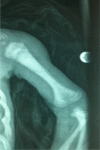Neurological manifestations in children with Sanjad-Sakati syndrome
- PMID: 23807856
- PMCID: PMC3686470
- DOI: 10.2147/IJGM.S40930
Neurological manifestations in children with Sanjad-Sakati syndrome
Abstract
Background: Sanjad-Sakati syndrome (SSS), also known as hypoparathyroidism-mental retardation-dysmorphism syndrome, or HRD, is a rare disorder characterized by growth and developmental delay, and by mental retardation and dysmorphic features.
Objective: The objective of this study was to clarify the clinical and neurological features of SSS.
Patients: Twenty-four patients were included in the study. They were seen at two hospitals in Kuwait.
Methods: This was a retrospective study of patients with SSS who attended the pediatric endocrinology, genetic, and neurology clinics in the Aladan and Alfarawanya hospitals in Kuwait from September 2007 to September 2012. Clinical and radiological data were obtained from each patient's medical records.
Results: All 24 patients had the characteristic dysmorphic features and laboratory findings of SSS. Consanguinity was reported in 75% of parents. Neurological manifestations in the form of microcephaly, developmental delay, mental retardation, and seizures were reported in all patients. Computerized tomography scans and/or magnetic resonance imaging showed evidence of intracranial calcifications in 29.2% of patients. Two patients showed a thin corpus callosum, and one patient showed intraventricular hemorrhaging.
Conclusion: Patients with SSS display a variety of dysmorphic features and neurological manifestations, including microcephaly, mental retardation, intracranial calcification, and epilepsy.
Keywords: Sanjad–Sakati syndrome; children; mental retardation; microcephaly; neurological manifestations.
Figures





Similar articles
-
Clinical features and tubulin folding cofactor E gene analysis in Iranian patients with Sanjad-Sakati syndrome.J Pediatr (Rio J). 2020 Jan-Feb;96(1):60-65. doi: 10.1016/j.jped.2018.07.005. Epub 2018 Aug 4. J Pediatr (Rio J). 2020. PMID: 30080992 Free PMC article.
-
Endocrinological Manifestations of Sanjad-Sakati Syndrome.Cureus. 2020 Jun 22;12(6):e8770. doi: 10.7759/cureus.8770. Cureus. 2020. PMID: 32714707 Free PMC article. Review.
-
Ophthalmic manifestations of Sanjad-Sakati syndrome.Ophthalmic Genet. 2006 Sep;27(3):83-7. doi: 10.1080/13816810600862568. Ophthalmic Genet. 2006. PMID: 17050283
-
Autoimmune thyroiditis associated with Sanjad-Sakati syndrome: A call for regular thyroid screening.Sudan J Paediatr. 2016;16(2):41-44. Sudan J Paediatr. 2016. PMID: 28096557 Free PMC article.
-
Oral Facial Manifestations of Sanjad-Sakati Syndrome: A Literature Review.Children (Basel). 2022 Mar 22;9(4):448. doi: 10.3390/children9040448. Children (Basel). 2022. PMID: 35455492 Free PMC article. Review.
Cited by
-
Clinical features and tubulin folding cofactor E gene analysis in Iranian patients with Sanjad-Sakati syndrome.J Pediatr (Rio J). 2020 Jan-Feb;96(1):60-65. doi: 10.1016/j.jped.2018.07.005. Epub 2018 Aug 4. J Pediatr (Rio J). 2020. PMID: 30080992 Free PMC article.
-
Sanjad Sakati syndrome and sleep-disordered breathing: an undisclosed association.Sleep Breath. 2022 Jun;26(2):815-821. doi: 10.1007/s11325-021-02463-4. Epub 2021 Aug 9. Sleep Breath. 2022. PMID: 34368942
-
Ring Chromosome 17 Not Involving the Miller-Dieker Region: A Case with Drug-Resistant Epilepsy.Mol Syndromol. 2017 Dec;9(1):38-44. doi: 10.1159/000479949. Epub 2017 Sep 15. Mol Syndromol. 2017. PMID: 29456482 Free PMC article.
-
Hypoparathyroidism-retardation-dysmorphism syndrome-Clinical insights from a large longitudinal cohort in a single medical center.Front Pediatr. 2022 Jul 22;10:916679. doi: 10.3389/fped.2022.916679. eCollection 2022. Front Pediatr. 2022. PMID: 35935360 Free PMC article.
-
Expanding the Phenotypic Spectrum of Kenny-Caffey Syndrome.J Clin Endocrinol Metab. 2023 Aug 18;108(9):e754-e768. doi: 10.1210/clinem/dgad147. J Clin Endocrinol Metab. 2023. PMID: 36916904 Free PMC article.
References
-
- Naguib KK, Gouda SA, Elshafey A, et al. Sanjad-Sakati syndrome/Kenny-Caffey syndrome type 1: a study of 21 cases in Kuwait. East Mediterr Health J. 2009;15(2):345–352. - PubMed
-
- Al-Malik MI. The dentofacial features of Sanjad-Sakati syndrome: a case report. Int J Paediatr Dent. 2004;14:136–140. - PubMed
LinkOut - more resources
Full Text Sources
Other Literature Sources
Molecular Biology Databases

